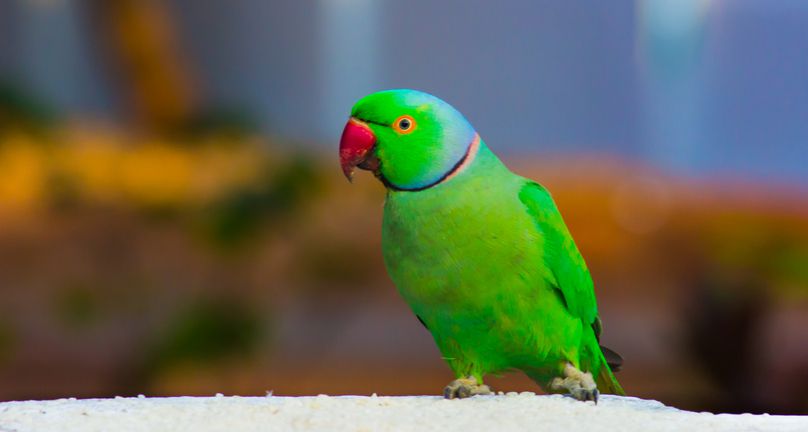
Scientific Name: Psittacula krameri
Description:
- Appearance: Indian Ringneck Parakeets are medium-sized parrots known for their distinctive long tail feathers and the unique ring around the neck in males. They have a slender build and a sharp, hooked beak. Commonly, they are bright green, but various color mutations exist, including blue, yellow, and white.
- Size: They typically measure about 16 inches (40 cm) in length, including the tail.
- Sexual Dimorphism: Mature males have a distinct colored ring around their necks, which is absent or much less prominent in females.
Lifespan:
- Indian Ringnecks can live for 20 to 30 years in captivity, with some living even longer under optimal care conditions.
Habitat:
- Natural Habitat: Originally from the Indian subcontinent and Central Africa, these birds thrive in forests and woodlands but have also adapted to urban areas.
- In Captivity: They require a spacious cage to accommodate their size and tail length, with plenty of room for flight and exercise. Enrichment through toys and perches is important.
Behavior:
- Social Interaction: Indian Ringnecks are known for their intelligence and ability to mimic speech. They are social and enjoy interaction but can be independent at times.
- Vocalization: They are capable of developing an extensive vocabulary and are known for their loud, high-pitched calls.
- Bonding: Once bonded with their human companions, they can be very affectionate. They may, however, take time to trust and bond with their owners.
Diet:
- In the Wild: They feed on seeds, fruits, vegetables, and nectar.
- In Captivity: A balanced diet for an Indian Ringneck should include high-quality pellets, fresh fruits and vegetables, and a limited amount of seeds and nuts. Fresh water should always be available.
Health Care:
- Veterinary Check-ups: Regular check-ups with an avian vet are important to monitor health. They can be prone to conditions like psittacosis, atherosclerosis, and nutritional deficiencies.
- Signs of Illness: Symptoms to watch for include changes in eating habits, lethargy, ruffled feathers, and abnormal droppings.
Breeding:
- Breeding in Captivity: Breeding Indian Ringnecks requires a commitment to providing the right environment, including a large nesting box and a balanced diet for the breeding pair.
- Clutch Size: The female typically lays 3 to 6 eggs per clutch.
Conservation Status:
- Indian Ringneck Parakeets are not currently endangered. They have a robust wild population and are also popular in the pet trade.
Tips for Potential Owners:
- Time and Attention: They need daily interaction and socialization to stay tame and engaged.
- Noise Level: They can be quite loud, which should be considered, especially in apartment settings.
- Training and Socialization: Early training and socialization are recommended to curb any tendencies toward nipping or behavioral issues.
Conclusion: Indian Ringneck Parakeets are beautiful, intelligent birds that make excellent companions for those who can meet their needs for social interaction, mental stimulation, and space. They require dedicated care and patience, especially during training and bonding, but the reward is a deeply affectionate and engaging pet.
FAQ’s
What is the lifespan of an Indian Ringneck Parakeet?
- Indian Ringneck Parakeets typically live for 20 to 30 years in captivity, and with optimal care, some can live even longer.
Can Indian Ringneck Parakeets talk?
- Yes, they are known for their excellent mimicking abilities and can develop an extensive vocabulary. They are among the best talkers in the parrot family.
What kind of diet is best for Indian Ringneck Parakeets?
- Their diet should include a balance of high-quality pellets, fresh fruits and vegetables, and a limited amount of seeds and nuts. Fresh water should always be available.
How much space does an Indian Ringneck need?
- They require a spacious cage due to their size and tail length. The cage should allow for flight and exercise, with plenty of room for toys and perches.
Are Indian Ringneck Parakeets good for beginners?
- While they can be great pets, their need for social interaction, mental stimulation, and their ability to be quite vocal makes them better suited for experienced bird owners.
How can I tell if my Indian Ringneck is healthy?
- Signs of a healthy Indian Ringneck include bright, clear eyes, clean feathers, active behavior, a good appetite, and normal droppings.
Do Indian Ringnecks need a lot of social interaction?
- Yes, they are social birds and require regular interaction and socialization to remain mentally stimulated and emotionally satisfied.
What are common health issues in Indian Ringnecks?
- Common issues include psittacosis, atherosclerosis, and nutritional deficiencies. Regular veterinary check-ups are essential for early detection and treatment.
How do I train my Indian Ringneck?
- Training should involve positive reinforcement techniques. They respond well to patience and consistency, and training sessions should be short and engaging.
Can Indian Ringnecks be kept with other birds?
- While they can coexist with other birds, careful introduction and monitoring are necessary. Indian Ringnecks can be territorial, especially during breeding season, so interactions should always be supervised.
These FAQs provide a general overview of Indian Ringneck Parakeets, helping potential and current owners understand the basics of their care, behavior, and needs.
